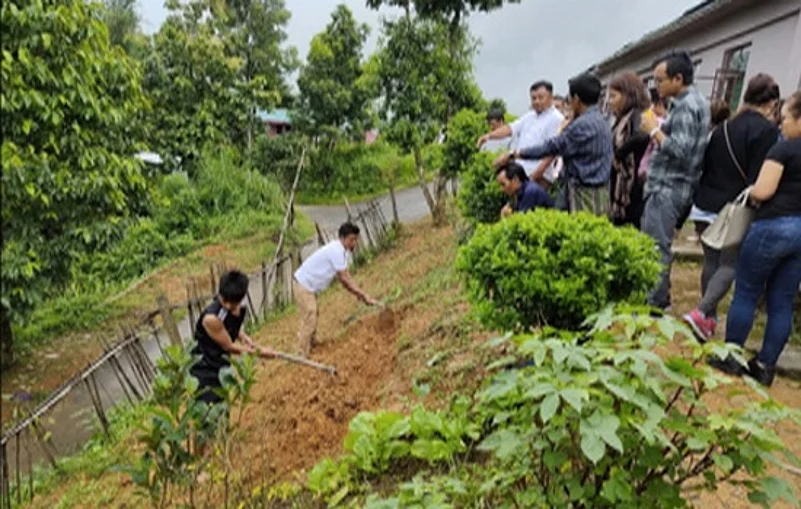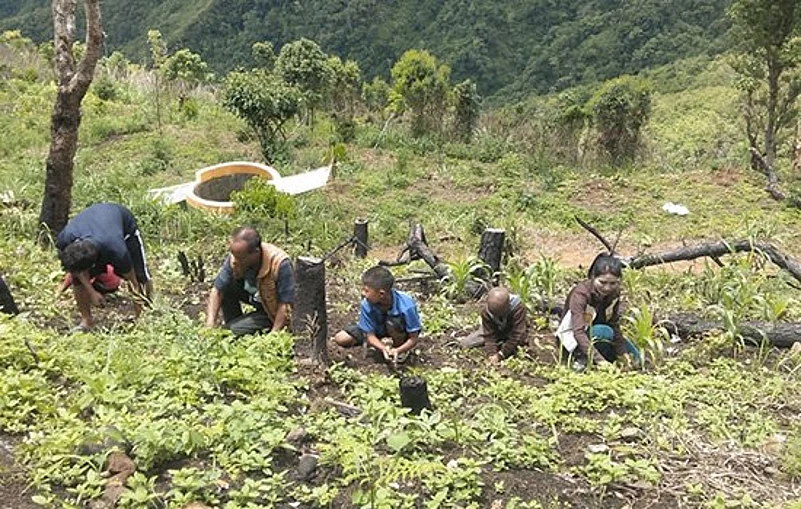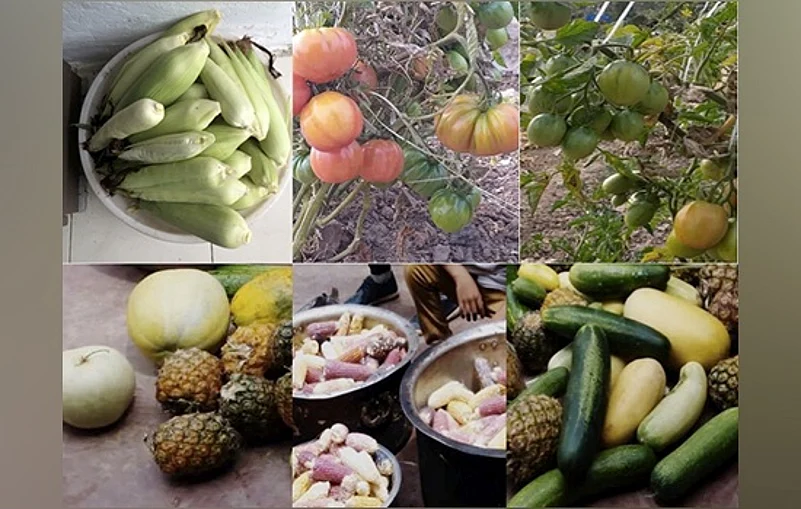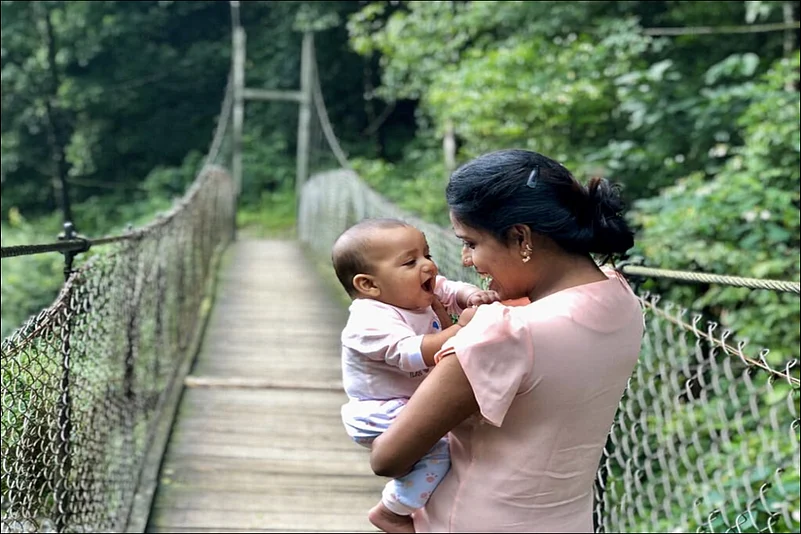As I joined as the Deputy Commissioner of Lawngtlai, Mizoram, I enrolled my one-year-old son in the nearest anganwadi. Though I was happy that he was making new friends in the neighbourhood, I saw that he was coming home with take home ration in small packets mostly of rice and dal. So, the first intervention was to make sure that hot cooked meals are served in the anganwadis. Further enquiry revealed that majority of the children in the anganwadi and schools were undernourished. A new and lactating mother myself and a strong advocator of exclusive breastfeeding, I could immediately link it to the unavailability of fresh fruits and vegetables and the inadequate infrastructure to cook a hot meal in the schools and anganwadis. This was when I realised that the problem is bigger than it looks. Upon multiple discussions with the stakeholders, community NGOs, church elders, we designed a programme that addresses the problem of unavailability and costly vegetables. This programme is called “Kan Sikul, Kan Huan” or My School, My farm.
Advertisement

We started with the anganwadis and schools with sufficient open space provided seeds, compost and other gardening equipment. The program with the ultimate objective of the production of its own vegetables also bought an important lesson to the children which were about the dignity of labour. The curriculum was also resigned to include one hour of SUPW (Socially Useful Productive Work) every day, so the children also become the stakeholder in the production and also learn important life lessons. The pilot project was extremely successful and results encouraging. It was later decided to launch this programme in all the anganwadis and schools of the district. Now we have steady flow of fresh vegetables and also help children to improve their dietary habits which stay with them for life.
Advertisement
The thought
When one hears that India has the maximum number of malnutrition children in the world and the progress of the world to meet the Sustainable Development Goals depends on the progress of India, what does one do? What do you do, knowing around 45 per cent of deaths among children under age five are linked to undernutrition? Buckle up, and work towards it. There is no reason why India, inspite of being one of the fastest growing economies, still has malnourished children.
Government of India has actively initiated many schemes and policies to reduce hunger and malnutrition in the country, mostly among children and women. The developmental, economic, social and medical impacts of malnutrition are serious and lasting for individuals, families, communities and the country. Poshan Abhiyaan, one among the many interventions for fighting malnourishment was exactly the right push, we needed. First 1000 days of every child (9 months in the womb + Year 1 + Year 2) are the most crucial for everything this country wants to achieve. If a child is malnourished, his health and learning ability is reduced, thus, he cannot achieve his potential in his youth leaving the country’s demographic dividend as a mere liability. This implies that, any interventions in health, education, sports, human resource, education, skill development, social welfare will not be completely successful until this child is fully ready to grasp the same. The learning outcomes of teachers and children in most rural areas are limited, mostly because they are malnourished and cannot cope up.

How do we achieve it?
Make sure every pregnant mother has the best nutrition to cover for the 9 months in the womb. Exclusive breastfeeding for first 6 months so again, best nutrition for the mother and 1.5 years of best nutrition for the child and mother. However, this is not happening in reality for various reasons. Mostly, poverty, lack of access to fresh fruits and vegetables, traditional food habits, poor maternal health, women engaged in exhausting domestic labor, less spacing between children and lack of apathy regarding breastfeeding and child care.
The divide between the gym room discussions of keto diet of the urban rich to rice and watery dal of the rural household is huge. Our country has achieved major milestones in doorstep delivery of food grains to almost all below poverty line households and many low income group households. Many states have added pulses, onions, oil, salt, sugar etc to their existing public distribution systems to ensure more items reach every household. However, we have a long way to go to achieve our nutritional potential. A colourful plate with the right quantity of proteins, vitamins, carbohydrates and minerals is the logical next step to our public distribution. Two questions arise:
Advertisement
1.Will the government step up and start distributing vegetables and fruits to the common man so that he can eat and be healthy?
2.Will we pool our resources at the village level and feed our children from the available sources?
Though I believe in redistribution of natural resources and the economics behind comparative advantage of resources, I also subscribe to the fact that, the power of the community, if they want, to achieve a particular goal, is unbeatable. This was the backdrop of our Nutrition garden Project.
The nutritional care of the pregnant and lactating mother along with the care of the newborn is mostly neglected in low income households for varied reasons. The top most reason being the lack of adequate nutrition available in the household. However, this remains the most crucial. If this, foundation and nutritional time is lost on a particular child, the inability to perform continues with him for life. This was what we set out to educate, through a series of outreach and sensitisation programmes. The district administration team along with NGOs and Church members were successful in educating people on the lifelong effects of a good nutritional foundation. The developmental, economic, social and medical impacts of malnutrition are serious and lasting for individuals, families, communities and the country.
Advertisement
Though, the Government is trying very hard to make interventions to end this vicious cycle of nutrition, every parent, every family, every village is equally responsible to understand the nutritional needs and try to provide the same. We encouraged them to pool their own community resources to create a small nutrition garden in every school and anganwadi and ensure one highly nutritious meal to every child and new mother. The departments of Horticulture, Agriculture, Soil conservation and Krishi Vikas Kendra provided series of technical trainings and hands on plantation sessions to all Headmasters, Mid-day meal coordinators and interested parents. The headmasters and parents were very excited on learning new and scientific techniques of plantation.
Advertisement
The interventions
1.Mapping of current schemes dealing with malnutrition and creating a robust convergence to ensure malnutrition free children by 2020
2.Small nutrition gardens in each school and anganwadi with different seasonal fruits and vegetables along with 2 compost pits for the waste.
3.Increasing the scope of services provided in schools and anganwadis by providing nutrient rich fruits and vegetables every day in the mid day meal from the school nutrition garden
4.Watershed management and retaining soil moisture and reducing landslide in hill areas by these gardens
5.Strengthening Self-help groups to create compost and produce high yielding variety of the seeds in the district itself so as to reduce dependency on other states and act as a supply chain to these schools
Advertisement
6.Inculcating the habit of working in their own farms and providing children with a real time look at how fruits and vegetables are grown. It is a recreational work experience in a hands-on learning environment where they will learn to nurture nature and understand the correlation between work and harvest.
Access Points
Government of India through various interventions has established Anganwadis at each village and mid deal meals in each school. Ministries of health and family welfare, Education, Social Welfare and Human Resource have toiled very hard to bring the schools and anganwadis to the stage that they are today. Anganwadis have amplified their responsibility of being a play school to kids below 5 years to being the access points for vaccinations, good nutrition, early learning and a backbone of health deliverables for pregnant and lactating mothers. Project nutrition garden is an attempt to converge the existing schemes available and enhance the output of these anganwadis and schools with a low cost intervention.
Advertisement
Integration of community resources
Most of the nutrition that comes to the anganwadis and schools are non-perishables and come in packets. Often remote places in the North east suffer from road blockages and landslides in the monsoon which prevent vehicles from delivering the nutrition packets. Since the vegetables and basic supply of salt and sugar comes from nearby Assam, the transit time is not suitable for perishable goods. To reduce the dependence on primitive markets, the strength of the community was utilised. Active SHGs from the district were motivated to create compost and high yielding variety of seeds, mostly local fruits and vegetables and these are being used by the schools. A series of handholding programs were held with NGOs, Church leaders, Village councils, headmasters and parents to create units of nutrition gardens using local resources. The programs were useful in sensitising them about the nutrition revolution one has to create at the school level to achieve self-sufficiency.
Advertisement

Healthy food habits
•All Schools and anganwadis will consume local, seasonal, organic and free fruits and vegetables everyday
•Increase the consumption of local varieties of turmeric and ginger as they are anti-septic in nature
•Include more channa, tomatoes, pumpkin, green leaves and mustard in the diet
•A hot vegetable stew with rice is the least minimum meal every child must be provided
•Growing their own vegetables and creating compost with degradable waste and water
•Children daily spending at least 15 mins in the garden to nurture the nature

The outcome
1.Reduction of malnourishment to less than 5% in all age groups of children and reduce stunting and wasting
Advertisement
2.Organic, fresh, cheap and local seasonal vegetables and fruits
3.Availability of nutrient rich fruits and vegetables throughout the year to all Schools, anganwadis and Child Care Institution
4.Re introducing pumpkin, corn, channa, ginger and turmeric etc in the daily diet as these are grown easily and widely in Lawngtlai.
5.Self-sufficiency in schools so as to reduce the market dependence for vegetables throughout the year
6.Healthy diet with adequate macro and micronutrients to help achieve the objectives of Poshan Abhiyaan and reduce growth stunting in children due to malnutrition.
7.Inculcating the habit of recycling, reusing and waste management amongst the children by teaching them how to utilize waste and other organic matter for creating compost.
Advertisement
8.Teaching children the importance of cultivating their own vegetables and spending atleast 1 hour every week in the backyard of their school thereby bringing about a behavioral change in society
Way forward
The seamless integration of the supply chain especially compost and seeds are on the cards. The plan is to achieve this with up gradation of SHGs dealing with them to technically train them and make them self-sufficient. Phase III of the project aims to add livestock and poultry to the schools so as to improve their protein content in the diet. The most important however lies in the sustainability and maintenance of the little gardens. Nutrition garden project ensures to provide children with a real time look at how fruits and vegetables are grown and also turn into a recreational work experience in a hands-on learning environment where they will learn to nurture nature and understand the correlation between work and harvest. It is an outdoor activity respite that is educational, health and environment friendly for children growing up in a world where they are engrossed in gadgets and technology. I hope that the new generation learn to be one with nature by their example and are grounded and healthy. That’s the best gift I would give my child and every other child in this country.




















